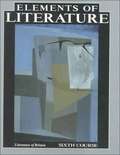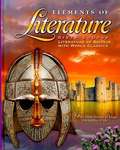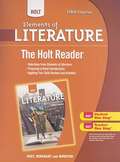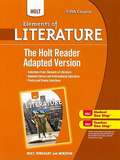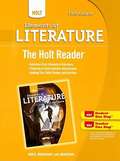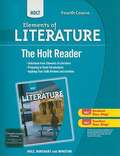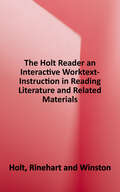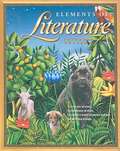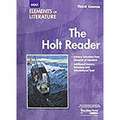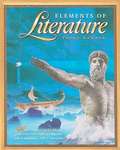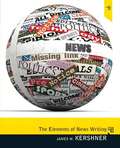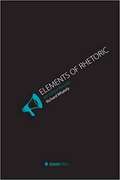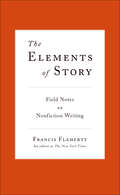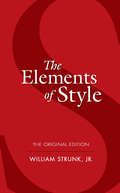- Table View
- List View
Elements of Literature, 6th Course: Literature of Britain with World Classics
by Robert E. Probst Robert Anderson John Malcolm Brinnin John Leggett Richard VaccaDiscover more about the stories, poems, and essays in Elements of Literature by logging on to the Internet. At go.hrw.com we help you complete your homework assignments, learn more about your favorite writers, and find facts that support your ideas and inspire you with new ones.
Elements of Literature, Fifth Course: Literature of the United States with Literature of the Americas
by Holt Rinehart WinstonThis resource book Elements of Literature Fifth Course contains a treasure of study materials primarily a literature of the United States with literature of the Americas.
Elements of Literature®, Fifth Course, The Holt Reader
by Holt Rinehart WinstonNIMAC-sourced textbook
Elements of Literature®, Fifth Course, The Holt Reader, Adapted Version
by Holt Rinehart WinstonNIMAC-sourced textbook
Elements of Literature (Florida Edition)
by Kylene Beers Robert AndersonThis is a collection of stories, poems, and essays to help students improve their literature skills.
Elements of Literature, Fourth Course
by Robert Anderson John Malcolm Brinnin John Leggett Janet Burroway Virginia Hamilton David Adams LeemingLiterature textbook for teens.
Elements Of Literature Fourth Course
by Holt Rinehart WinstonThe authors of this have established the literary framework of the Elements of Literature program and developed instructional materials for the elements of drama, poetry, and fiction in the book.
Elements of Literature®, Fourth Course, The Holt Reader
by Holt Rinehart WinstonNIMAC-sourced textbook
Elements of Literature, Grade 12: Holt Reader: Interactive Worktext (Elements Of Literature Ser.)
by Holt Rinehart and Winston StaffThe Holt Reader: An Interactive WorkText is a book created especially for you. It is a size that’s easy to carry around. This book actually tells you to write in it, circling, underlining, and jotting down responses to the literature and related materials. In addition to outstanding selections and background information providing the context for these selections, you’ll find graphic organizers that encourage you to think a different way. This is designed to accompany Elements of Literature. Like Elements of Literature, it helps you interact with the literature and background materials. The chart below shows you what’s in the book and how it’s organized.
Elements of Literature, Grade 6 Introductory Course
by Holt Rinehart WinstonSchool textbook on literature.
Elements of Literature (Kentucky Edition)
by Holt Rinehart WinstonElements of Literature Kentucky Edition has standards are separated into five categories: Reading, Writing, Speaking/Listening/Observing, Inquiry, and Technology as Communication. At the Elements of Literature Internet site, you can read texts by professional writers and learn the inside stories behind your favorite authors. You can also build your word power and analyze messages in the media.
Elements Of Literature Second Course
by Robert Anderson John Malcolm Brinnin John Leggett David Adams LeemingElements Of Literature Second Course is specially designed to accommodate all students to learn literature, enabling them to acquire a skill at a time. It gives teachers an exciting way to teach in the classrooms as it also provides a teachers manual for every course titles. The English Department could not have a better book that masters, captures and informs on the elements of literature.
Elements of Literature, Second Course
by Robert Anderson John Malcolm Brinnin John Leggett David Adams Leeming Naomi ShihabThroughout this book, you'll find some short passages that have been read by a reader whose responses are noted in the margin. Different readers will have different responses, but everyone who reads has some reaction. You should be aware of your responses as you read; at times, you will want to write them down. They will be useful when you write about the story later on. If you own a book, you can write in it as much as you like. Since this isn't true of a textbook, you should write your responses on paper.
Elements of Literature Third Course: The Holt Reader
by Holt Rinehart WinstonHigh School Language Arts Textbook
Elements of Literature (Third Course)
by Holt Rinehart WinstonHolt Elements will help students improve their reading and comprehension skills.
Elements of Literature Third Course Illinois Edition
by BeersElement of Literature a Language Arts Textbook.
Elements of Literature Third Course (Michigan Edition)
by Holt Rinehart Winston9th Grade Literature Textbook
Elements of Moral Cognition
by John MikhailIs the science of moral cognition usefully modeled on aspects of Universal Grammar? Are human beings born with an innate 'moral grammar' that causes them to analyse human action in terms of its moral structure, with just as little awareness as they analyse human speech in terms of its grammatical structure? Questions like these have been at the forefront of moral psychology ever since John Mikhail revived them in his influential work on the linguistic analogy and its implications for jurisprudence and moral theory. In this seminal book, Mikhail offers a careful and sustained analysis of the moral grammar hypothesis, showing how some of John Rawls' original ideas about the linguistic analogy, together with famous thought experiments like the trolley problem, can be used to improve our understanding of moral and legal judgement.
Elements of News Writing
by James W. KershnerKershner's The Elements of News Writing 3/e is a concise handbook that presents the essential rules of journalism, while offering in-depth analysis of the evolving industry. With comprehensive coverage from history to how-to, and discussions of new media, online journalism, blogging, and social networking, this text covers news writing from a 360 degree view. <P><P> The Elements of News Writing covers the basics of news writing without the extra verbiage. The author pays extra attention to grammar and usage, with easy-to-follow basic tips on writing for all types of mass media, new and old.
Elements of Rhetoric
by Richard Whately Whately RichardThis classical text was once dismissed as a mere reaffirmation of Aristotle's doctrine of syllogistic reasoning, standing in opposition to the new logic of scientific induction that dominated the modern era of logic and rhetoric. Yet today Elements of Logic again offers a number of useful principles for teaching reasoning and critical thinking to undergraduates, helping them to understand that common reasoning patterns are a constant across subjects and contexts. As the linear reasoning patterns of the inductive scientific method are fading, students are constantly exposed to, and seek out, information that comes in short bursts and is dominated by visual and aural stimuli. Those who must create new models of reasoning to fit ever-evolving forms of electronic media may find guidance and inspiration in Whately's work.
The Elements of Story: Field Notes on Nonfiction Writing
by Francis FlahertyA relentlessly entertaining, totally accessible writing guide for the novice and the professional alike.Most writing books dwell on common issues of style and grammar. Yet most writers also confront complex problems of story design. This fifty-rule guide by Francis Flaherty, a New York Times editor, offers much-needed solutions and sage advice to address these concerns.“Sometimes, say things sideways,” Flaherty writes. “The reader will be grateful.” “White is whitest on black,” he observes. “Let contrast work for you.” Through such hard-won, story-level insights, sprinkled with examples from real stories and leavened with a good dose of newsroom memoir, The Elements of Story merits a spot on every writer’s shelf.
The Elements of Style: The Original Edition
by William Strunk Jr.The original edition of the most trusted writer's guide to American English, this is the book that generations of writers have relied upon for timeless advice on grammar, diction, syntax, sentence construction, and other writing essentials. In brief and concise terms, author William Strunk, Jr., identifies the principal requirements of proper American English style and concentrates on the most often violated rules of composition.Originally published in 1918, this authoritative and engagingly written manual retains its immediacy and relevance. Strunk begins with the basic rules of usage, offering accessible explanations of correct punctuation and grammar. His advice on the principles of composition cites concrete examples of how to maintain clarity by eliminating redundancy and unnecessary embellishment. In addition, Strunk provides valuable pointers on avoiding common errors in the usage of words and expressions, and in spelling. The greatest book of its kind, this volume is a must for any student or writer.
